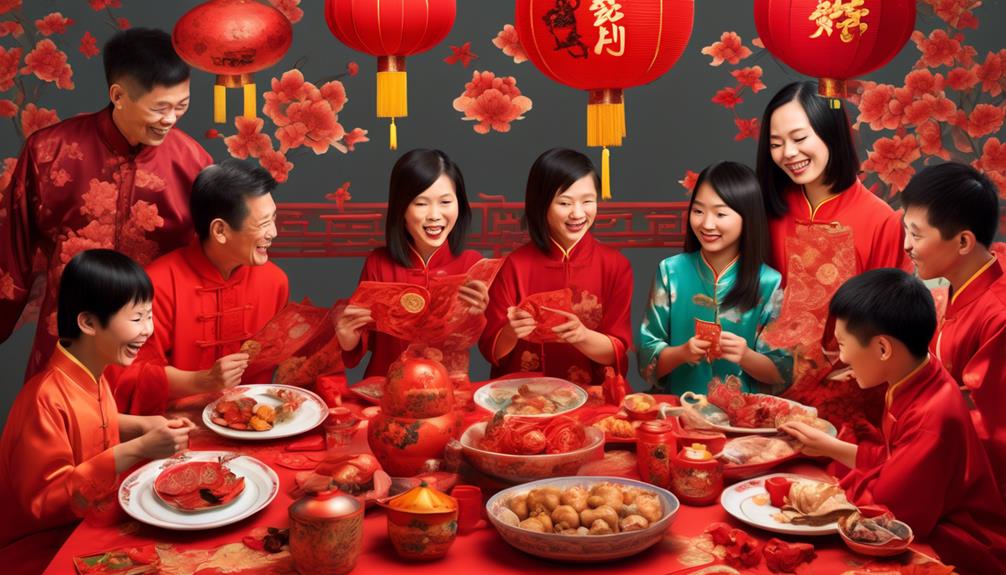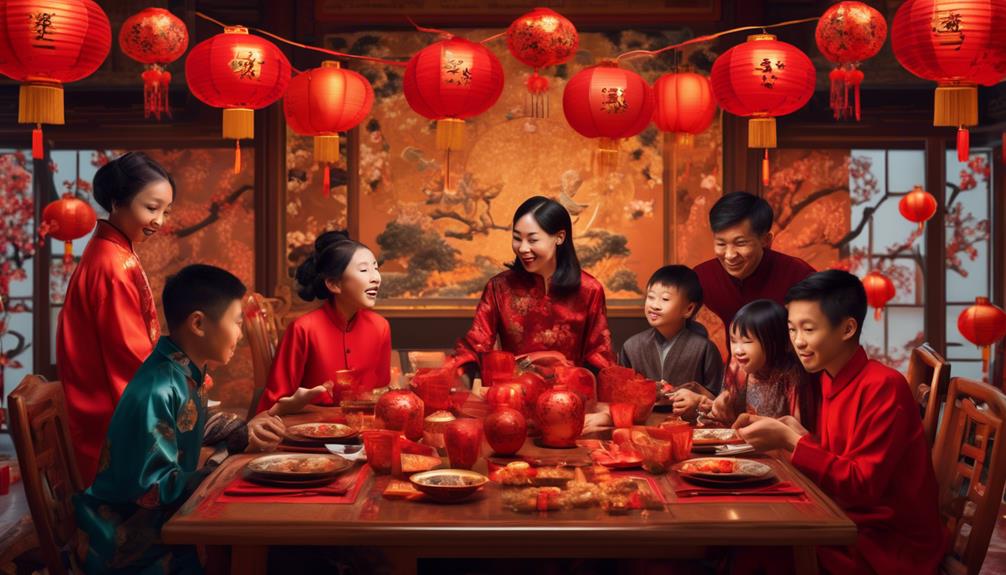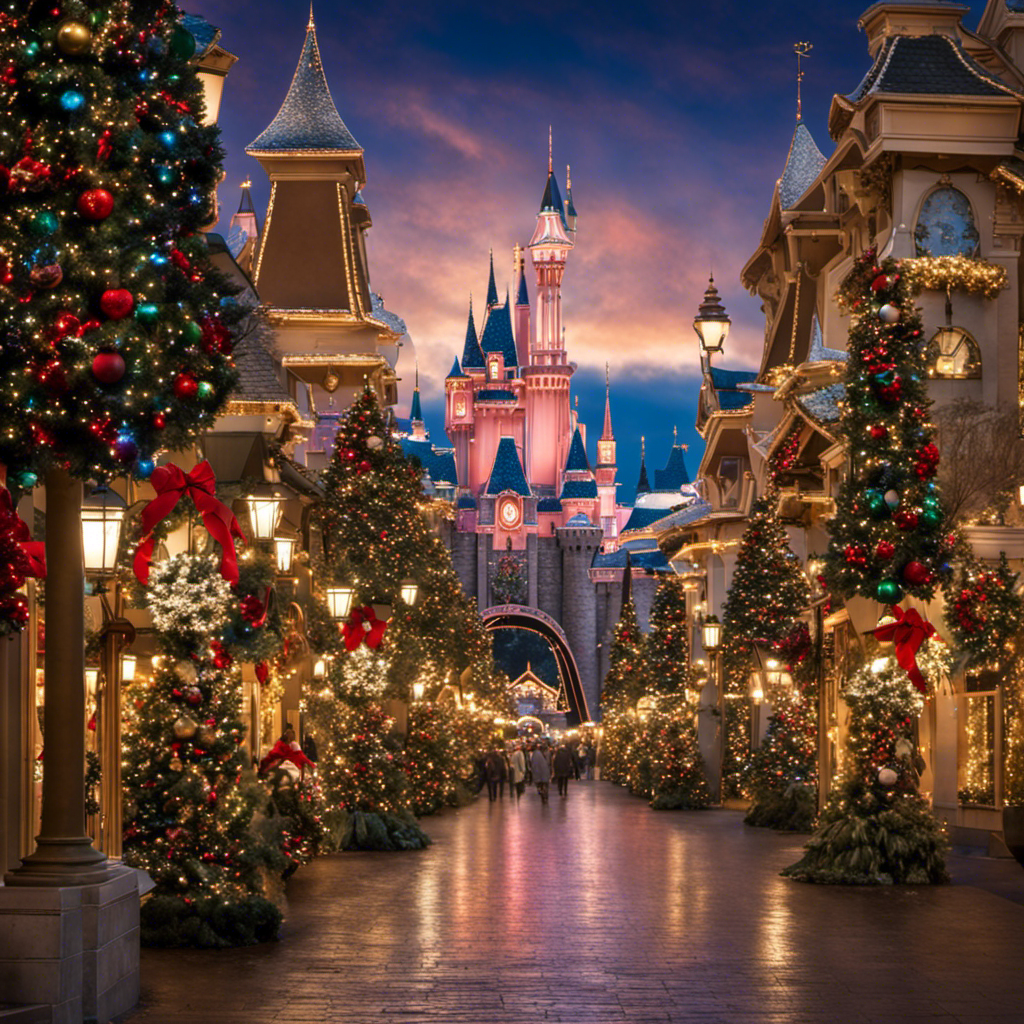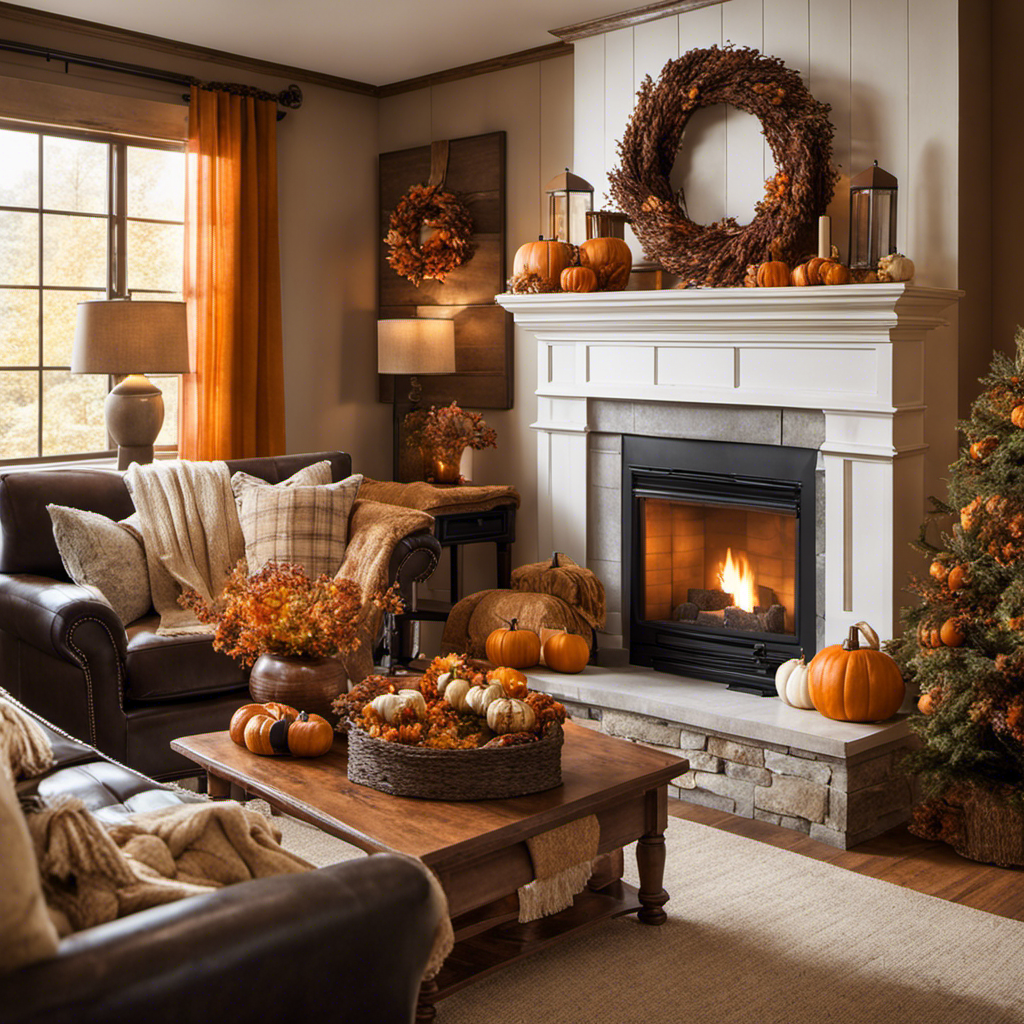Decor
Why Is Chinese New Year Celebrated Differently?
2025

As the adage states, ‘Different strokes for different folks.’ In the context of commemorating Chinese New Year, the rituals and practices significantly diverge from those found in other cultural celebrations. As an author, it’s essential to explore the historical background, cultural foundations, and diverse factors that have contributed to the distinctive nature of this festivity.
From the lunar calendar and its impact on determining the date of the festivities, to the symbolic decorations and their profound meanings, there are numerous aspects to explore. Additionally, the importance of family and reunion, the significance of festive foods, and the regional variations in celebrations all contribute to the distinctiveness of Chinese New Year.
Moreover, with modern adaptations and the global influence of this holiday, it becomes even more intriguing to understand why Chinese New Year is celebrated differently.
Key Takeaways
- Chinese New Year is celebrated differently due to its historical origins and cultural roots in the agrarian society of China.
- The Lunar Calendar plays a crucial role in determining the dates and traditions of Chinese New Year.
- Traditional customs and rituals, such as symbolic decorations and festive foods, are deeply rooted in Chinese culture and play a vital role in the celebrations.
- Chinese New Year celebrations vary regionally due to the migration of different ethnic groups throughout Chinese history.
Historical Origins and Cultural Roots
The historical origins and cultural roots of Chinese New Year can be traced back thousands of years, making it one of the oldest and most significant celebrations in Chinese culture. The evolution of Chinese New Year has been influenced by various historical events and cultural traditions.
Chinese New Year, also known as the Spring Festival, has its roots in the ancient agrarian society of China. It originated from the need to celebrate the end of winter and the beginning of spring, a time when farmers would prepare for the upcoming planting season. This agricultural connection is still evident today, as the festival coincides with the lunar calendar and marks the start of the farming year.
The historical influences on Chinese New Year are vast and diverse. One major influence is the introduction of Buddhism to China, which brought with it various rituals and customs that became integrated into the festival. Additionally, the migration of different ethnic groups throughout Chinese history has contributed to the regional variations in how Chinese New Year is celebrated.
Lunar Calendar and Its Influence

As we delve into the influence of the Lunar Calendar, we uncover the profound impact it has had on the evolution and celebration of Chinese New Year. The Lunar Calendar, based on the cycles of the moon, plays a crucial role in determining the dates of this important festival. The influence of lunar phases on Chinese New Year is evident in the traditional celebrations and modern adaptations.
In the traditional celebrations, the Lunar Calendar determines the exact date of Chinese New Year. It follows a 12-year cycle, with each year represented by a specific animal sign. People born in the year of a particular animal are believed to possess the characteristics of that animal. This lunar influence also affects the choice of auspicious activities and rituals performed during the festival, such as lion dances and fireworks, which are believed to ward off evil spirits and bring good fortune for the coming year.
In modern times, the influence of the Lunar Calendar has been adapted to accommodate the needs of a changing society. While the lunar dates remain significant, the use of a solar calendar has also been incorporated to synchronize with the Gregorian calendar. This allows for easier planning and coordination of activities, especially for businesses and international engagements.
Traditional Customs and Rituals
When it comes to Chinese New Year, the traditional customs and rituals hold great significance. Symbolic decorations, such as red lanterns and couplets, are used to bring good luck and ward off evil spirits.
Festive foods, like dumplings and fish, are prepared and shared with loved ones to symbolize abundance and prosperity. Cultural performances, such as dragon and lion dances, are performed to bring joy and excitement to the celebrations.
These customs and rituals are deeply rooted in Chinese culture and play a vital role in ushering in the new year with auspiciousness and unity.
Symbolic Decorations
Symbolic decorations play a vital role in Chinese New Year celebrations, infusing each home with auspicious symbols and vibrant colors. These decorations are deeply rooted in ancient traditions and hold significant symbolic meanings.
Here are three traditional practices associated with symbolic decorations during Chinese New Year:
- Red Lanterns: Red is considered a lucky color in Chinese culture and symbolizes good fortune and joy. Hanging red lanterns in homes and streets is believed to ward off evil spirits and bring luck and happiness for the upcoming year.
- Paper Cuttings: Intricate paper cuttings depicting various auspicious symbols, such as flowers, animals, and Chinese characters, are commonly displayed on windows and doors. These paper cuttings are believed to bring blessings, ward off evil spirits, and invite prosperity into the household.
- Kumquat Trees: Kumquat trees are popular decorations during Chinese New Year as they symbolize wealth and prosperity. The pronunciation of 'kumquat' sounds similar to the word for 'gold' in Chinese, thus representing good fortune and abundance.
Festive Foods
During Chinese New Year, as families adorn their homes with symbolic decorations, another integral aspect of the celebration comes to life through the preparation and consumption of festive foods steeped in traditional customs and rituals. Festive foods play a significant role in Chinese New Year, symbolizing good luck, prosperity, and auspiciousness.
While there are regional variations in the types of dishes enjoyed, certain foods are commonly found on every Chinese New Year table. For example, dumplings are a staple in Northern China, representing wealth and good fortune. In southern regions, glutinous rice cakes, known as nian gao, are popular, symbolizing growth and progress.
In recent years, there have also been modern adaptations of traditional dishes, incorporating new flavors and ingredients to cater to changing tastes. However, no matter the regional variation or modern adaptation, the preparation and consumption of festive foods remain an important cultural practice during Chinese New Year.
Cultural Performances
Cultural performances during Chinese New Year bring ancient traditions and rituals to life, captivating audiences with their vibrant displays and preserving the rich heritage of the festival. These performances encompass a variety of traditional dances and music that have been passed down through generations.
- Lion Dance: One of the most iconic Chinese New Year performances, the Lion Dance is a dynamic and acrobatic display. Performers dress up as lions and mimic their movements, believed to bring good luck and ward off evil spirits.
- Dragon Dance: Similar to the Lion Dance, the Dragon Dance involves a team of performers moving a long dragon puppet in synchronized movements. This dance symbolizes power, strength, and prosperity.
- Traditional Music: Chinese New Year celebrations are incomplete without the enchanting sounds of traditional music. The melodies of instruments like the erhu, pipa, and guzheng create a festive atmosphere and evoke a sense of nostalgia.
These cultural performances not only entertain but also serve as a reminder of the rich cultural heritage and values that the Chinese New Year represents.
Symbolic Decorations and Their Meanings

As we delve into the vibrant world of Chinese New Year celebrations, one cannot help but be captivated by the profound symbolism that adorns homes and streets during this auspicious time. Symbolic decorations play a significant role in Chinese New Year festivities, representing cultural traditions and conveying deeper meanings.
To better understand the rich symbolism behind these decorative elements, let's explore some common examples in the table below:
| Decoration | Meaning |
|---|---|
| Red Lanterns | Symbolize good fortune and ward off evil spirits |
| Paper Cutouts | Represent wishes for happiness, wealth, and longevity |
| Kumquat Trees | Signify prosperity and good luck in the coming year |
| Door Couplets | Feature poetic phrases to bring blessings and ward off negativity |
Each of these decorations carries cultural significance and holds a special place in Chinese New Year celebrations. From the vibrant red lanterns that symbolize good fortune to the intricate paper cutouts that express wishes for happiness and longevity, every decoration contributes to the festive atmosphere and reflects the hopes and aspirations of the Chinese people.
Importance of Family and Reunion

When it comes to Chinese New Year celebrations, family takes center stage. The importance of family and reunion is deeply ingrained in the traditions and customs surrounding this auspicious holiday.
From the grand feasts shared with loved ones to the exchange of red envelopes filled with blessings, every aspect of Chinese New Year emphasizes the significance of togetherness and the bond between family members.
Family-Centric Celebrations
The heart of Chinese New Year celebrations lies in the deep-rooted value placed on family and the joyous reunions that take place during this auspicious time. Family traditions and cultural practices play a significant role in shaping the festivities, making it a truly family-centric celebration.
Family Reunion Dinner: The highlight of Chinese New Year is the family reunion dinner, known as 'Nian Ye Fan.' This lavish feast brings generations together, with family members traveling from far and wide to be with their loved ones.
Red Envelopes: Another important family tradition during Chinese New Year is the giving of red envelopes, known as 'Hong Bao.' These envelopes, filled with money, symbolize good luck and blessings for the upcoming year. They're usually given by older family members to the younger ones, fostering a sense of unity and generosity.
Ancestor Worship: Chinese New Year is also a time to honor ancestors through rituals and ceremonies. Families visit ancestral gravesites, light incense, and offer food and prayers, paying respect to their ancestors and seeking their blessings for the new year.
These family-centric celebrations not only strengthen family bonds but also preserve the rich cultural heritage of the Chinese people.
Symbolism of Reunion
Reunion holds immense symbolism in Chinese culture, epitomizing the profound importance of family and the cherished tradition of coming together. Symbolism plays a significant role in Chinese New Year celebrations, and the act of reuniting with loved ones carries deep cultural significance.
It's a time when families gather from far and wide, setting aside differences and embracing the bond that unites them. This tradition symbolizes the values of filial piety, respect for elders, and the passing down of cultural heritage from one generation to the next.
The reunion dinner, known as 'Nian Ye Fan,' is a central part of the celebrations, where families come together to share a festive feast and exchange well wishes for the upcoming year.
The act of reuniting during Chinese New Year not only strengthens family ties but also reaffirms the importance of unity and harmony within the community.
Cultural Significance of Togetherness
As we explore the cultural significance of togetherness in Chinese New Year celebrations, it becomes evident that the act of reuniting with loved ones goes beyond mere gatherings, embodying the deep-rooted values of family and the cherished tradition of coming together.
The Chinese New Year is a time when families come together to celebrate their cultural traditions and reinforce their bonds of love and kinship. It's a time for family members, near and far, to set aside their differences and come together in harmony.
The importance of family and reunion is emphasized during this festive season, as it serves as a reminder of the value of community bonding and the strengthening of familial ties. The act of gathering together in celebration creates a sense of belonging and unity, fostering a strong sense of identity and cultural pride.
Festive Foods and Their Significance

During Chinese New Year celebrations, a diverse array of mouthwatering dishes fill the tables, each with its own unique significance and symbolism. The significance of culinary traditions during this festive season is deeply rooted in Chinese culture and has evolved over time.
One of the most iconic Chinese New Year dishes is the dumpling, or jiaozi. Its crescent shape resembles ancient Chinese gold or silver ingots, symbolizing wealth and prosperity for the coming year.
Another popular dish is fish, which represents abundance and surplus. In Chinese, the word for fish, 'yu,' sounds similar to the word for surplus, highlighting the desire for a bountiful year ahead.
Nian gao, or sticky rice cake, is another staple during Chinese New Year. Its sticky texture symbolizes cohesiveness and unity within the family. The pronunciation of 'nian gao' is similar to the phrase 'nian nian gao sheng,' which means 'every year, may you reach higher heights.' This signifies the desire for continuous improvement and progress.
As the Chinese diaspora has spread across the globe, the evolution of festive dishes has become more diverse. In addition to traditional Chinese dishes, various regional cuisines have been incorporated into Chinese New Year celebrations.
For example, in Malaysia and Singapore, yusheng, a colorful raw fish salad, is popular during this time. It's believed that the higher the toss, the greater the prosperity for the upcoming year.
Regional Variations in Celebrations

The culinary traditions and festive dishes of Chinese New Year vary across different regions, reflecting the diverse cultural influences and culinary practices within the Chinese diaspora. Regional variations in customs play a significant role in shaping the celebrations of Chinese New Year.
Here are three examples of how cultural diversity is showcased during this festive time:
- Southern China: In Southern China, particularly in Guangdong and Fujian provinces, the focus of Chinese New Year celebrations is on seafood. Families gather to enjoy elaborate seafood feasts, featuring dishes like steamed fish, braised abalone, and stir-fried shrimp. The abundance of seafood symbolizes prosperity and good fortune in the coming year.
- Northern China: In contrast, Northern China places greater emphasis on wheat-based dishes. Dumplings, known as jiaozi, are a staple during Chinese New Year. Families come together to make and eat dumplings, which are believed to bring wealth and good luck. The shape of the dumplings resembles ancient Chinese currency, symbolizing prosperity.
- Overseas Chinese communities: Chinese New Year celebrations in overseas Chinese communities often incorporate local traditions and customs. For example, in Malaysia and Singapore, the Chinese diaspora celebrates with a unique blend of Chinese, Malay, and Indian influences. Festivities include lion dances, fireworks, and the exchange of mandarin oranges for good luck.
These regional variations highlight the rich tapestry of Chinese culture and the importance of cultural diversity in celebrating Chinese New Year.
Modern Adaptations and Global Influence

In today's interconnected world, Chinese New Year has undergone modern adaptations and gained global influence, transcending cultural boundaries and captivating people of diverse backgrounds. The celebration of Chinese New Year has evolved over time to accommodate the changing needs and preferences of communities around the world. In many countries, Chinese New Year festivities have been adapted to suit local customs and traditions, resulting in unique global adaptations.
One example of a global adaptation is the incorporation of non-Chinese elements into the celebrations. In countries with significant Chinese populations, such as Malaysia and Singapore, Chinese New Year has fused with local traditions, creating a vibrant blend of cultures. For instance, in Malaysia, the lion dance, a traditional Chinese performance, is accompanied by local Malay music and dance styles. This cross-cultural influence not only enhances the festive atmosphere but also promotes cultural exchange and understanding.
Furthermore, Chinese New Year celebrations have become an increasingly popular tourist attraction, drawing visitors from all over the world. In cities like Sydney, London, and San Francisco, Chinese New Year parades, fireworks displays, and street festivals have become major events on the cultural calendar. These global adaptations of Chinese New Year not only promote cultural diversity but also contribute to the local economy through tourism and business opportunities.
Frequently Asked Questions
What Is the History Behind the Lunar Calendar and Its Influence on Chinese New Year Celebrations?
The lunar calendar history and its influence on Chinese New Year celebrations are fascinating.
The lunar calendar, which has been used for thousands of years, plays a crucial role in determining the date of Chinese New Year. It's based on the cycles of the moon and has deep cultural and religious significance for the Chinese people.
This calendar's influence is evident in the various customs and traditions associated with Chinese New Year, making it a unique and cherished holiday.
How Do Traditional Customs and Rituals Play a Role in Chinese New Year Celebrations?
Traditional customs and rituals play a significant role in Chinese New Year celebrations. They bring the community together, fostering a sense of unity and belonging.
The exchange of red envelopes symbolizes good fortune and blessings.
The lion and dragon dances showcase the vibrant culture and ward off evil spirits.
Fireworks hold great significance, as they're believed to scare away bad luck and bring in a prosperous new year.
These customs and rituals create a festive atmosphere and strengthen cultural identity during this important holiday.
What Are Some Symbolic Decorations Used During Chinese New Year and What Do They Represent?
Symbolic decorations during Chinese New Year hold great significance and meaning. They're an integral part of traditional customs and rituals, which play a crucial role in preserving our cultural heritage.
These decorations, such as red lanterns, couplets, and paper cuttings, are believed to bring good luck, prosperity, and ward off evil spirits. Each decoration represents different blessings and wishes for the upcoming year.
They create a festive and auspicious atmosphere, making Chinese New Year celebrations unique and special.
Why Is Family and Reunion Considered Important During Chinese New Year Celebrations?
During Chinese New Year celebrations, the importance of family and reunion can't be overstated. Family is considered the cornerstone of Chinese culture and plays a central role in the festivities.
Reunion holds great significance as it brings together loved ones from near and far, fostering a sense of unity and togetherness. This emphasis on family and reunion is rooted in traditional values of filial piety and respect for elders.
It's a time to honor ancestors, strengthen familial bonds, and create lasting memories with loved ones.
How Do Festive Foods Hold Significance in Chinese New Year Celebrations?
Festive foods play a crucial role in Chinese New Year celebrations. They hold deep cultural significance and are prepared with traditional recipes and cooking techniques. These dishes aren't only delicious but also have auspicious meanings and food symbolism.
From dumplings symbolizing wealth and good fortune to whole fish representing abundance, each dish carries a symbolic message.
Families gather for festive feasts, enjoying traditional dishes that have been passed down through generations, keeping culinary traditions alive during this special time of year.
How Does the Chinese Zodiac and Animal Years Influence the Celebration of Chinese New Year?
The Chinese Zodiac and animal years are a vital part of the celebration of Chinese New Year, deeply ingrained in China’s cultural traditions. Each year is represented by a different animal, influencing people’s personalities and fate. China animal year tradition adds symbolism and significance to the festivities, with various customs and rituals associated with each zodiac sign. This ancient practice enhances the sense of unity and excitement during the Chinese New Year celebrations.
Conclusion
In conclusion, Chinese New Year is celebrated differently due to its historical origins, cultural roots, and the influence of the lunar calendar. The traditional customs, symbolic decorations, and festive foods all hold significant meanings and play a vital role in the celebrations.
Furthermore, regional variations add diversity and uniqueness to the festivities. As an example, in southern China, the Lion Dance is a prominent tradition, while in northern China, the custom of making dumplings together symbolizes unity and prosperity.
Despite modern adaptations and global influence, Chinese New Year remains deeply rooted in its rich traditions and continues to bring joy and blessings to millions around the world.
- About the Author
- Latest Posts
Introducing Ron, the home decor aficionado at ByRetreat, whose passion for creating beautiful and inviting spaces is at the heart of his work. With his deep knowledge of home decor and his innate sense of style, Ron brings a wealth of expertise and a keen eye for detail to the ByRetreat team.
Ron’s love for home decor goes beyond aesthetics; he understands that our surroundings play a significant role in our overall well-being and productivity. With this in mind, Ron is dedicated to transforming remote workspaces into havens of comfort, functionality, and beauty.

Upon entering my house, I am welcomed by a perfect combination of traditional and contemporary elements. The cozy feel of classic antiques harmonizes seamlessly with the clean, modern aesthetics.
In this article, I will guide you through the art of incorporating antiques into your modern decor. From selecting the perfect pieces to masterfully mixing furniture styles, we will uncover the secrets to creating a space that exudes timeless charm and contemporary allure.
So, let us embark on this journey of transforming your home into a captivating tapestry of past and present.
Key Takeaways
- Consider the size and style of the antiques you choose.
- Mix antique and contemporary furniture to add history and personality to your space.
- Use antique lighting fixtures, textiles, and art to create a sense of timelessness and sophistication.
- Pay attention to the overall color palette and materials to create a cohesive antique modern aesthetic.
Choosing the Right Antiques for Your Modern Space
When choosing antiques for your modern space, it’s important to consider their size and style.
Antique lighting fixtures can add a touch of elegance and charm to any room. Look for chandeliers or wall sconces that have intricate details and a timeless appeal.
Vintage textiles, such as rugs or curtains, can bring warmth and character to your space. Seek out patterns and textures that complement your overall design aesthetic.
Mixing antique and contemporary furniture can create a unique and eclectic look. By incorporating antiques into your modern decor, you can add a sense of history and personality to your space.
It’s all about finding the right balance and creating a cohesive look that reflects your personal style.
Mixing Antique and Contemporary Furniture
To achieve a harmonious blend of old and new styles, try mixing antique and contemporary furniture in your home decor. This combination adds depth and character to any space, creating a unique and personal aesthetic. Here are a few ways to evoke an emotional response and create a truly captivating environment:
-
Mix antique and industrial furniture: Pairing an antique wooden dining table with modern metal chairs creates a striking contrast that adds visual interest and creates a conversation piece.
-
Incorporate antique textiles into modern decor: Adding vintage rugs, tapestries, or embroidered pillows to your contemporary space brings warmth and history, making it feel cozy and inviting.
-
Embrace the juxtaposition: Place an antique cabinet next to a sleek, modern sofa or use an antique dresser as a TV stand. This unexpected pairing creates a sense of intrigue and surprise.
By seamlessly blending old and new elements, your home will become a reflection of your unique style and personality.
Now, let’s explore how to incorporate antique art and decorative pieces into your modern decor.
Incorporating Antique Art and Decorative Pieces
You can enhance the charm and character of your home by seamlessly blending antique art and decorative pieces with your contemporary style. Antique art and decorative pieces add a touch of history and uniqueness to any space, creating a sense of timelessness and sophistication.
One way to incorporate antique art is by using antique lighting fixtures, such as vintage chandeliers or sconces, which can become a focal point in a modern room. Additionally, incorporating antique textiles, such as vintage rugs, tapestries, or embroidered fabrics, can add texture and visual interest to your space. These pieces can be used as wall hangings, throw pillows, or even reupholstered onto modern furniture.
Combining Antiques With Modern Color Schemes
By seamlessly blending antique art and decorative pieces with modern color schemes, you can create a visually stunning and harmonious space. This unique combination allows you to bring together the charm of vintage items with the sleekness of contemporary design. Here are three ways in which this amalgamation can evoke an emotional response in the audience:
-
The juxtaposition of antique accessories against modern lighting fixtures creates a sense of nostalgia and warmth, while adding a touch of elegance and sophistication.
-
The vibrant colors of modern artwork paired with antique furniture pieces create a dynamic contrast that sparks curiosity and intrigue.
-
Incorporating antique textiles, such as tapestries or rugs, into a modern color scheme adds depth and texture, evoking a sense of coziness and comfort.
As you delve into showcasing antiques in a minimalist interior, you will discover new ways to elevate your space and create a truly unique and personal environment.
Showcasing Antiques in a Minimalist Interior
Blending antique pieces with a minimalist interior can create a sleek and timeless design. When incorporating antiques into a minimalist space, the key is to maximize space with carefully chosen antique furniture. By selecting smaller, more compact pieces, you can maintain the clean lines and open feel of a minimalist interior while still showcasing the unique charm of antiques.
Consider incorporating antique side tables or chairs with slim profiles, or even repurposing antique trunks as coffee tables for added storage. To create a cohesive antique modern aesthetic, it’s important to pay attention to the overall color palette and materials. Opt for neutral tones and natural materials such as wood, metal, or stone to complement both the antique and modern elements in the space.
With deliberate curation and thoughtful design choices, you can seamlessly integrate antiques into a minimalist interior, resulting in a stylish and timeless space.
Frequently Asked Questions
How Do I Determine the Value of an Antique Piece Before Incorporating It Into My Modern Space?
Before incorporating an antique into my modern space, I determine its value by assessing its authenticity. This involves researching its provenance, consulting experts, and considering factors like condition, rarity, and market demand.
Are There Any Specific Design Styles That Work Best When Mixing Antique and Contemporary Furniture?
When mixing antique and contemporary furniture, it’s important to consider specific design styles. By blending elements of traditional and modern aesthetics, you can create a unique and balanced look in your home.
What Are Some Creative Ways to Display Antique Art and Decorative Pieces in a Modern Setting?
Innovative display techniques for showcasing antique art in a modern home can bring a unique charm to your space. Strategies for integrating antique decorative pieces into a contemporary interior design can create a captivating blend of old and new.
How Can I Incorporate Antiques Into a Modern Color Scheme Without Overwhelming the Space?
Incorporating antiques into a modern color scheme requires a thoughtful balance of vintage and contemporary elements. By carefully selecting pieces that complement the color palette and integrating them into the overall design, a harmonious and stylish space can be achieved.
What Are Some Tips for Showcasing Antiques in a Minimalist Interior Without Cluttering the Space?
When it comes to showcasing antiques in a minimalist interior, the key is finding a balance between the old and new elements. Here are some tips for creating a cohesive look when mixing antiques and modern furniture. Start by selecting a few statement antique pieces that can serve as focal points, ensuring they don’t overwhelm the space. Incorporate modern elements with clean lines and neutral tones to create contrast and let the antiques shine. Additionally, consider mixing metals in home decor, such as pairing a vintage brass chandelier with contemporary stainless steel accents, to bridge the gap between the eras and add visual interest.
Conclusion
In conclusion, incorporating antiques into modern decor is like adding a touch of magic to your space. It brings a sense of history and depth, transforming your home into a captivating museum.
By carefully selecting the right antiques, mixing them with contemporary furniture, and showcasing them in a minimalist setting, you can create a truly unique and mesmerizing atmosphere.
So go ahead and embrace the beauty of the past, and let your modern space become a treasure trove of timeless elegance.
- About the Author
- Latest Posts
Meet Katherine, the creative enthusiast at ByRetreat who infuses her boundless passion for design into every remote workspace she crafts. With an innate sense of creativity and an eye for unconventional beauty, Katherine brings a unique and inspiring perspective to the team.
Katherine’s love for design is infectious, and her ability to think outside the box sets her apart. She believes that true artistry lies in embracing a variety of styles and mixing them harmoniously to create captivating spaces. By combining different textures, colors, and patterns, Katherine weaves a tapestry of creativity that breathes life into each remote workspace.

I absolutely adore the enchanting holiday season transformation that occurs at Disneyland! The atmosphere becomes even more festive, with Christmas cheer radiating from every corner, and the park adorned with beautiful decorations that truly make you feel like you’ve stepped into a winter wonderland.
But when, oh when, does the Christmas decor go up at Disneyland? Fear not, my fellow Disney enthusiasts, for I am here to reveal the secrets of this festive spectacle. The magic of the holiday season typically begins to blanket the park in early November, right after the Halloween festivities conclude. This seamless transition ensures there’s no delay in bringing the Christmas cheer to life, while also marking the best time to add fall decor in those final autumnal weeks. By mid-November, Disneyland is fully transformed into a winter wonderland, complete with twinkling lights, themed treats, and iconic attractions dressed in their holiday best.
So fasten your seatbelts and get ready to be dazzled as we embark on a journey through the whimsical world of Disneyland during the most wonderful time of the year.
Key Takeaways
- Christmas decor is put up in early November at Disneyland.
- The park becomes a magical wonderland with twinkling lights, festive music, and the scent of holiday treats.
- Sleeping Beauty Castle undergoes a transformation into a winter wonderland with thousands of sparkling lights.
- The Haunted Mansion and It’s a Small World ride receive festive Christmas makeovers, offering unique holiday experiences.
Early November: The Start of the Holiday Transformation
You’ll notice that in early November, Disneyland starts the holiday transformation by putting up Christmas decor. The park becomes a magical wonderland, filled with twinkling lights, festive music, and the scent of holiday treats in the air.
One of the most enchanting moments is when the castle lighting ceremony takes place. As night falls, thousands of sparkling lights illuminate Sleeping Beauty Castle, creating a breathtaking sight that truly captures the spirit of the season.
Throughout the park, you’ll also encounter beloved holiday characters like Mickey and Minnie, decked out in their festive attire, ready to spread cheer and joy. The magic of Disneyland during the holidays is truly unparalleled.
Now, let’s step into the next section and explore the festive entryways of Disneyland’s main entrance.
Festive Entryways: Disneyland’s Main Entrance
As you approach the main entrance of Disneyland, the festive atmosphere immediately envelops you with its vibrant colors and joyful ambiance. The entrance is adorned with twinkling lights and larger-than-life decorations that transport you into a world of magic and wonder.
Here are a few things that make Disneyland’s Main Entrance truly enchanting:
- The iconic Mickey-shaped floral arrangement, meticulously crafted with seasonal blooms, welcomes you with a cheerful smile.
- The sound of cheerful holiday music fills the air, creating a sense of excitement and anticipation.
- A towering Christmas tree, adorned with shimmering ornaments and sparkling lights, stands tall in the center, spreading holiday cheer to all who pass by.
As you make your way through Disneyland’s Main Entrance, the enchantment continues to build, leading you to the next magical experience: Sleeping Beauty’s Winter Castle, a breathtaking centerpiece that will leave you in awe.
Sleeping Beauty’s Winter Castle: A Magical Centerpiece
As I walked into Disneyland, my eyes were immediately drawn to the majestic Sleeping Beauty’s Winter Castle. Its transformation from a regular castle to a winter wonderland was nothing short of magical.
I couldn’t help but wonder how they managed to accomplish such a breathtaking transformation process. And of course, as one of the most popular photo spots in the park, I couldn’t wait to capture the beauty and wonder of the castle in all its glory.
Castle Transformation Process
Don’t worry, the castle transformation process at Disneyland is already underway for Christmas decor. As the holiday season approaches, the park is buzzing with excitement, preparing to create a magical atmosphere for visitors from around the world.
Here’s what you can expect from the castle transformation process:
-
The castle lighting: Imagine the Sleeping Beauty Castle adorned with thousands of sparkling lights, illuminating the night sky with a warm glow. The castle lighting is one of the most breathtaking sights during the holiday season.
-
Holiday music and entertainment: As you stroll through the park, you’ll be serenaded by cheerful holiday tunes and entertained by festive performances, adding to the joyful atmosphere.
-
Festive decorations: From garlands and wreaths to ornaments and ribbons, every corner of Disneyland will be decked out in festive decorations, creating a magical wonderland.
With the castle transformation process well underway, Disneyland is gearing up to be a popular photo spot, capturing the holiday spirit and creating memories that will last a lifetime.
Popular Photo Spot?
With the castle transformation process well underway, Disneyland is becoming a popular spot for capturing festive photos that will create lasting memories.
As I stroll through the park, I can’t help but notice the excitement in the air. Families and friends gather around the iconic decorations, eagerly posing for pictures. The castle, adorned with twinkling lights and shimmering ornaments, serves as the perfect backdrop for these charming snapshots.
Laughter fills the air as children, dressed in their holiday best, strike poses with wide smiles. The atmosphere is contagious, and even I can’t resist joining in on the fun. It’s heartwarming to see everyone come together, embracing the holiday spirit.
And speaking of holiday spirit, let’s explore how popular attractions get a Christmas makeover, adding even more enchantment to Disneyland’s magical world.
Holiday Overlays: Popular Attractions Get a Christmas Makeover
The Haunted Mansion and It’s a Small World ride at Disneyland get a festive Christmas makeover during the holiday season. It’s truly a sight to behold as these beloved attractions transform into winter wonderlands right before your eyes.
Here are three reasons why these holiday overlays are a must-see:
-
The Haunted Mansion Holiday: Step inside the iconic mansion and experience the spooky meets merry atmosphere as Jack Skellington takes over the mansion, turning it into a whimsical celebration of the season.
-
It’s a Small World Holiday: Embark on a magical journey around the world as this classic boat ride becomes a dazzling display of holiday cheer. Each country showcases unique holiday traditions and decorations, making it a truly global celebration.
-
Enchanting Music and Lights: The combination of holiday-themed music and breathtaking light displays enhances the festive atmosphere, creating a truly immersive experience.
As you explore these enchanting attractions, you’ll be transported to a world of holiday magic. But the Christmas cheer doesn’t stop there.
Let’s now venture into the decked halls of Disneyland’s iconic decorations.
Decked Halls: Disneyland’s Iconic Decorations
As the popular attractions at Disneyland receive their festive makeovers, the holiday atmosphere is taken to an entirely new level with the iconic decorations adorning the castle and other areas of the park. The sight of the castle transformed into a dazzling winter wonderland is truly breathtaking.
To give you a visual representation of the enchanting castle decorations and other iconic adornments, here is a table showcasing some of Disneyland’s most beloved holiday decor:
| Area of the Park | Decorations | Description |
|---|---|---|
| Main Street | Garland, wreaths, lights | A charming, nostalgic display greets visitors |
| Sleeping Beauty’s Castle | Snow, icicles, lights | The centerpiece of the park, transformed into a magical winter retreat |
| Haunted Mansion | Creepy Christmas decor | A spooky twist on holiday decorations |
With the park fully decked out in its holiday best, the enchanting decorations create a truly magical atmosphere. Everywhere you turn, there’s a sense of wonder and joy in the air, making Disneyland the perfect place to celebrate the holiday season.
And speaking of holiday celebrations, the next section will take us to the must-see spectacle of the Christmas parade.
Christmas Parade: A Must-See Spectacle
Don’t miss out on the must-see spectacle of the Christmas parade at Disneyland. It’s a magical experience that truly captures the spirit of the season. Here’s what makes it so special:
-
The Christmas parade is a must-see spectacle, featuring enchanting floats adorned with twinkling lights, beloved Disney characters in their festive attire, and joyful holiday music that will have you dancing along.
-
It’s a popular photo spot, with picture-perfect moments at every turn. From Mickey and Minnie in their holiday best to the breathtakingly beautiful floats, you’ll want to capture these memories forever.
-
The parade is also a great opportunity to shop for exclusive Disneyland gifts. You’ll find a wide range of holiday merchandise, from ornaments to clothing, that you won’t find anywhere else.
-
And let’s not forget about the festive live performances and seasonal treats! As the parade makes its way through the park, you’ll be treated to lively dances, heartwarming songs, and delicious holiday treats that will make your taste buds sing.
With so much to see and experience, the Christmas parade at Disneyland is an absolute must. After all, it’s just the beginning of the joyful entertainment: seasonal shows and performances that await you at the happiest place on earth.
Joyful Entertainment: Seasonal Shows and Performances
As a Disneyland enthusiast, I can’t help but get excited about the festive live performances that take place during the holiday season.
From the enchanting musicals to the captivating dance routines, these performances add an extra touch of magic to the already enchanting park.
And let’s not forget about the seasonal show schedules, which are carefully curated to ensure that visitors get to experience the best of Disneyland’s holiday entertainment.
Festive Live Performances
There’s nothing quite like the festive live performances at Disneyland during the holiday season. The park comes alive with music, dancing, and excitement that truly captures the magic of Christmas.
Here are some of the highlights of these incredible performances:
-
Festive Parades: The streets of Disneyland are transformed into a winter wonderland as colorful floats, costumed characters, and joyful music fill the air. The parade features all your favorite Disney characters, spreading holiday cheer to everyone who watches.
-
Holiday Concerts: Get ready to be serenaded by the sounds of the season as talented singers and musicians take the stage. From classic Christmas carols to modern holiday hits, these concerts are sure to get you in the festive spirit.
-
Spectacular Dance Shows: Prepare to be dazzled by the incredible choreography and energy of the holiday dance performances. With elaborate costumes and breathtaking routines, these shows are a feast for the eyes.
As the live performances at Disneyland bring the holiday spirit to life, you’ll also want to make sure you catch the seasonal show schedules to make the most of your visit.
Seasonal Show Schedules
Make sure you check out the seasonal show schedules at Disneyland to plan your visit and catch all the festive live performances. From festive parades to holiday concerts, Disneyland offers a variety of entertainment options that will get you into the holiday spirit. The park has a packed schedule of shows and performances that cater to everyone’s tastes. Whether you’re a fan of classic holiday tunes or prefer the excitement of a vibrant parade, there’s something for everyone. To help you plan your visit, here’s a table showcasing some of the upcoming shows and their timings:
| Show Name | Location | Time |
|---|---|---|
| Jingle Bell, Jingle BAM! | Main Street | 11:00 AM, 2:00 PM, 5:00 PM |
| A Christmas Fantasy Parade | Parade Route | 1:00 PM, 4:00 PM, 7:00 PM |
| Holiday Wishes Fireworks Spectacular | Sleeping Beauty Castle | 9:00 PM, 10:30 PM |
With such a diverse range of shows, you’ll be able to plan your day at Disneyland to make sure you don’t miss any of the festive fun. So, grab your schedule, pick your favorite shows, and get ready to be dazzled by the magical holiday entertainment at Disneyland.
Disneyland Holiday Entertainment
Don’t forget to check out the diverse range of holiday shows and performances at Disneyland to plan your day and ensure you don’t miss any of the festive fun. Immerse yourself in the magical holiday atmosphere as Disneyland brings the holiday spirit to life with its incredible array of entertainment options. Here’s a taste of what you can expect:
-
Awe-inspiring parades: Get ready to be dazzled by the enchanting holiday parades, where your favorite Disney characters come to life in vibrant costumes and catchy tunes.
-
Spectacular fireworks: End your day with a bang as the night sky lights up with breathtaking fireworks, set to a festive soundtrack that will leave you in awe.
-
Heartwarming stage shows: From beloved Disney classics to heartwarming holiday tales, the stage shows at Disneyland will captivate audiences of all ages.
Now, get ready to indulge in delicious holiday flavors as we dive into the next section about seasonal treats.
Seasonal Treats: Indulge in Delicious Holiday Flavors
You’ll find an array of delectable holiday flavors to indulge in at Disneyland during the Christmas season. From warm and comforting holiday beverages to whimsical Christmas themed desserts, there’s something for every taste bud.
Sip on a cup of rich and creamy hot chocolate, topped with fluffy marshmallows and a sprinkle of peppermint. Indulge in a slice of decadent gingerbread cake, adorned with festive icing and edible snowflakes. Treat yourself to a freshly baked sugar cookie shaped like Mickey Mouse, decorated with colorful icing and sprinkles.
The combination of flavors and the festive presentation will transport you into a winter wonderland of deliciousness. And after satisfying your sweet tooth, you can continue your holiday adventure by exploring the festive merchandise: unique souvenirs and gifts that capture the magic of the season.
Festive Merchandise: Unique Souvenirs and Gifts
When it comes to holiday souvenirs, Disneyland offers a range of must-have items that are sure to bring joy to any Disney enthusiast.
From festive ornaments and Mickey-themed apparel to limited edition pins and collectible plush toys, there is something for everyone to cherish and remember their magical vacation.
And for those looking for something truly exclusive, Disneyland also offers a selection of gifts that can only be found within the park, making them the perfect keepsakes to commemorate a truly special visit.
Must-Have Holiday Souvenirs
One of the must-have holiday souvenirs at Disneyland is the limited edition Christmas ornament. These ornaments are beautifully crafted and designed to capture the magic of the holiday season.
Here are three reasons why these holiday ornaments are a must-have:
-
Exquisite Designs: Each Christmas ornament is intricately designed with attention to detail. From iconic Disney characters to enchanting holiday scenes, these ornaments are a true work of art.
-
Collectible Items: Disneyland releases a new limited edition ornament each year, making them highly sought after by collectors. Owning one of these ornaments is not only a way to commemorate your visit to Disneyland during the holiday season, but also to build a cherished collection.
-
Lasting Memories: Hanging these ornaments on your Christmas tree every year will bring back memories of your magical time at Disneyland. They serve as a reminder of the joy and happiness you experienced during the holiday season at the happiest place on earth.
As you explore the world of festive merchandise at Disneyland, there are also exclusive Disneyland gifts that you won’t want to miss out on.
Exclusive Disneyland Gifts
Don’t miss out on the exclusive gifts available only at Disneyland. From limited edition Disneyland pins to one-of-a-kind collectibles, there’s something for every Disney fan to cherish. Take a look at some of the amazing merchandise you can find:
| Item | Description |
|---|---|
| Mickey Mouse Plush | A cuddly plush toy featuring Mickey in his holiday attire |
| Disneyland Ornament Set | A set of beautifully crafted ornaments showcasing park icons |
| Star Wars Lightsaber | An authentic replica of a lightsaber from the Star Wars saga |
| Princess Tiara | A sparkling tiara fit for a Disney princess |
These exclusive Disneyland gifts are not only unique, but they also capture the magic and nostalgia of the park. Whether you’re a collector or simply looking for a special souvenir, these limited edition items are sure to bring joy and happiness. So, make sure to visit the Disneyland gift shops and bring home a piece of the magic.
And speaking of magic, after you’ve picked out your exclusive gifts, get ready for an enchanting spectacle: the holiday fireworks. Experience the wonder and beauty of the nighttime sky as it is illuminated with bursts of color and sparkle. It’s a breathtaking display that will leave you in awe and make your visit to Disneyland truly unforgettable.
Holiday Fireworks: A Spectacular Nighttime Display
You’ll love the holiday fireworks at Disneyland – they put on a spectacular nighttime display! Picture this: as the sun sets and darkness envelops the park, the sky above Cinderella Castle comes alive with a burst of vibrant colors. The fireworks illuminate the night, creating a mesmerizing spectacle that will leave you in awe.
Here’s why you won’t want to miss it:
- The fireworks display is choreographed to popular holiday tunes, adding an extra layer of magic to the experience.
- The combination of pyrotechnics, music, and special effects creates an immersive sensory experience that will transport you into a world of wonder.
- Watching the fireworks from Main Street, with Sleeping Beauty Castle as the backdrop, is an unforgettable sight that captures the essence of the holiday season.
With the extended park hours, you can enjoy the magic late into the night, immersing yourself in the enchanting atmosphere that Disneyland offers during the holiday season.
Extended Park Hours: Enjoy the Magic Late Into the Night
Make sure to take advantage of the extended park hours at Disneyland, so you can fully enjoy the magic late into the night. As the sun sets and the stars begin to twinkle, Disneyland transforms into a whimsical wonderland of late night entertainment.
The park comes alive with dazzling lights, enchanting music, and a sense of excitement that is truly contagious. One of the highlights of the extended park hours is the holiday themed parades. Imagine watching a procession of beloved Disney characters, all decked out in their festive attire, dancing and singing their way down Main Street.
The floats are adorned with twinkling lights and adorned with holiday decorations, creating a mesmerizing spectacle that is sure to fill your heart with joy. So grab a hot cocoa, find a cozy spot, and let the magic of Disneyland’s late night entertainment transport you to a world of holiday enchantment.
Frequently Asked Questions
Are There Any Special Events or Performances During the Christmas Season at Disneyland?
During the Christmas season at Disneyland, there are special Christmas parades and holiday themed fireworks that add an extra touch of magic to the park. It’s a wonderful time to visit and experience the holiday spirit!
Can I Purchase Holiday-Themed Merchandise at Disneyland During This Time?
Yes, you can purchase holiday-themed merchandise at Disneyland during this time! They have an array of festive items featuring popular Disney characters in adorable holiday attire. It’s a magical shopping experience!
Will There Be Any Changes to the Park’s Operating Hours During the Christmas Season?
During the Christmas season, Disneyland’s operating hours may change to accommodate the increased crowd levels. It’s an exciting time to visit the park with extended hours and festive decorations all around.
Are There Any Specific Treats or Foods That Are Unique to the Holiday Season at Disneyland?
Oh, there are so many unique holiday treats and Disneyland festive foods to enjoy during the Christmas season! From gingerbread cookies to peppermint churros, the park is filled with delicious and festive delights that will surely satisfy any sweet tooth.
Are the Popular Attractions at Disneyland Transformed With Christmas Decorations?
Yes, the popular attractions at Disneyland are transformed with beautiful Christmas decorations. It’s truly magical to see your favorite rides and characters surrounded by the festive spirit of the season.
Conclusion
As I walk through the gates of Disneyland in early November, I am instantly transported into a winter wonderland. The holiday transformation is in full swing, with festive decorations adorning every corner. I can’t help but be in awe of Sleeping Beauty’s Winter Castle, a magical centerpiece that glistens in the sunlight.
As I make my way through the park, I am delighted to see popular attractions like It’s a Small World and Haunted Mansion getting a Christmas makeover. The halls are decked with lights and garlands, creating a truly enchanting atmosphere. And the seasonal treats, oh the treats! Indulging in delicious holiday flavors is a must-do, from peppermint mochas to gingerbread cookies.
As I browse through the festive merchandise, I can’t resist taking home unique souvenirs and gifts to remember this magical experience. And as night falls, I am treated to a spectacular display of holiday fireworks, lighting up the sky with bursts of color and joy. The extended park hours allow me to enjoy the magic late into the night, creating memories that will last a lifetime.
Disneyland during Christmas is a truly enchanting experience, where the spirit of the season comes alive in the most magical way.
- About the Author
- Latest Posts
Meet Katherine, the creative enthusiast at ByRetreat who infuses her boundless passion for design into every remote workspace she crafts. With an innate sense of creativity and an eye for unconventional beauty, Katherine brings a unique and inspiring perspective to the team.
Katherine’s love for design is infectious, and her ability to think outside the box sets her apart. She believes that true artistry lies in embracing a variety of styles and mixing them harmoniously to create captivating spaces. By combining different textures, colors, and patterns, Katherine weaves a tapestry of creativity that breathes life into each remote workspace.

As the cool air begins to settle and the leaves start to change color, I excitedly welcome the arrival of autumn.
It’s that time of year when cozy sweaters and pumpkin spice everything fill my senses, and I can’t help but feel the urge to bring the beauty of the season into my home.
Join me as we explore the perfect timing for starting fall decor, from early September’s gentle introduction to late November’s seamless transition into winter elements.
Let’s create a space that captures the essence of autumn and sets the stage for a season of warmth and celebration.
Key Takeaways
- Early September is a good time to start adding fall decor to your home and incorporating fall-inspired recipes into your cooking routine.
- Mid-September is the optimal time to embrace the changing seasons and infuse your space with cozy fall decor.
- Late September is the time to transition into autumn decor by incorporating warm tones, natural elements, and creating a warm and inviting atmosphere.
- Early October is the perfect time to add cozy touches to your home with autumn accessories, plush blankets, soft pillows, scented candles, and engaging in fall-inspired DIY projects.
Early September: Getting a Head Start on the Fall Vibes
You can start embracing the fall vibes by adding some early September decor to your home. As the leaves begin to change color and the air becomes crisper, it’s the perfect time to infuse your space with cozy and inviting elements.
One way to do this is by incorporating fall inspired recipes into your cooking routine. Think hearty soups, baked goods with warm spices, and comforting drinks like apple cider.
Another way to fully immerse yourself in the season is by engaging in outdoor fall activities. Take leisurely walks through the park, go apple picking, or gather around a bonfire with friends and family. These activities not only allow you to enjoy the beautiful scenery but also create lasting memories.
As September progresses, transitioning into the next stage of embracing the changing seasons becomes even more exciting.
Mid-September: Embracing the Changing Seasons
When it comes to creating the perfect autumn ambiance in my home, timing is everything. I’ve found that mid-September is the optimal time to start embracing the changing seasons and infusing my space with cozy fall decor.
By this point, the weather has started cooling down, leaves are beginning to change color, and there’s a certain crispness in the air that just screams ‘fall.’
From warm-toned throw pillows and scented candles to rustic wreaths and pumpkin accents, I love how these little touches can instantly transform my home into a welcoming haven for the autumn season.
Optimal Fall Decor Timing
The best time to start fall decor is during the month of September. As the leaves begin to change color and the air becomes crisp, it’s the perfect opportunity to bring the cozy and warm ambiance of fall into your home. To help you get started, I’ve gathered some fall decor inspiration and trends in the table below:
| Trendy Fall Decor Ideas | Cozy Color Palette | Nature-Inspired Accents | DIY Projects |
|---|---|---|---|
| Pumpkin Spice Everything | Earthy Browns and Oranges | Dried Leaves and Pinecones | Handmade Wreaths |
| Farmhouse Chic | Deep Burgundy and Mustard Yellow | Birch Logs and Twigs | Mason Jar Candle Holders |
| Rustic Elegance | Rich Plums and Hunter Greens | Antlers and Feathers | Fall Leaf Garland |
With these ideas in mind, you can transform your space into a cozy autumn retreat. Now, let’s move on to creating a welcoming autumn ambiance without skipping a beat.
Welcoming Autumn Ambiance
To create a warm and inviting atmosphere this autumn, consider incorporating cozy lighting and earthy scents into your space.
As the leaves begin to change color and the air becomes crisp, it’s the perfect time to embrace fall-inspired crafts and autumn-inspired recipes.
One of my favorite crafts to do during this season is making DIY leaf garlands with colorful foliage collected from nature walks. It adds a touch of nature’s beauty to any room.
And when it comes to recipes, nothing beats the comforting aroma of pumpkin spice and cinnamon wafting through the house. Whether it’s a homemade pumpkin pie or a comforting apple cider, these autumn-inspired recipes are sure to bring a sense of coziness to your home.
Late September marks the transition into autumn decor, so let’s explore how to seamlessly incorporate this seasonal change into your space.
Late September: Transitioning Into Autumn Decor
You can start incorporating autumn decor into your home in late September. As the leaves change color and the weather begins to cool, it’s the perfect time to transition your home’s style to reflect the cozy ambiance of the season.
One way to do this is by incorporating the autumn color palette into your decor. Think warm tones like deep oranges, rich browns, and golden yellows. Incorporate these colors into your throw pillows, blankets, and even artwork.
Another way to transition your home is by incorporating natural elements such as dried branches, pinecones, and acorns. These can be used in centerpieces, wreaths, or even as standalone decorations.
By incorporating these touches, you can create a warm and inviting atmosphere that welcomes the arrival of fall.
As late September transitions into early October, it’s time to add even more cozy touches to your home.
Early October: Adding Cozy Touches to Your Home
As October begins, it’s time to infuse your home with cozy touches that embrace the spirit of the season. One of the best ways to do this is by adding cozy autumn accessories to your living space.
Think plush throw blankets in warm, earthy tones, soft pillows with fall-inspired patterns, and scented candles that evoke the scent of crisp autumn air. These simple additions can instantly transform your home into a cozy haven.
Additionally, fall inspired DIY projects are a great way to add a personal touch to your decor. From crafting your own wreath using colorful leaves and pinecones to painting pumpkins in unique designs, the possibilities are endless. Get creative and let your imagination run wild.
Now, let’s transition into mid-October, where we celebrate the harvest season.
Mid-October: Celebrating the Harvest Season
As we transition into mid-October, it’s the perfect time to embrace the harvest season and infuse our homes with warm and inviting fall decor. From richly colored foliage wreaths to pumpkin-scented candles, small touches can transform any space into a cozy autumn retreat. While planning for festive gatherings, consider incorporating unique elements like Wisconsin New Year decorations to add a touch of regional charm and creativity. These unexpected accents can seamlessly complement traditional fall decor, making your home feel both festive and personal.
In this discussion, we will explore some early fall decor ideas that will bring a touch of autumnal charm to your living spaces.
From vibrant pumpkin displays to rustic harvest-themed home accents, we’ll delve into creative ways to celebrate the beauty of this season.
Early Fall Decor Ideas
Decorating your home with early fall decor can create a cozy and inviting atmosphere. As the leaves start to change color and the air becomes crisper, it’s the perfect time to bring the beauty of the season indoors. Here are some ideas to inspire you:
-
Early fall color schemes:
-
Incorporate warm hues like burnt orange, deep red, and golden yellow into your decor.
-
Mix in earthy tones like brown and olive green to create a natural, autumnal feel.
-
Don’t be afraid to experiment with subtle pops of color, like plum or mustard.
-
DIY fall wreaths:
-
Gather fallen leaves, pinecones, and branches to create a rustic wreath.
-
Add a touch of elegance with dried flowers and berries.
-
Personalize your wreath by incorporating elements that reflect your style, such as ribbons or miniature pumpkins.
Harvest-Themed Home Accents
To add a festive touch to your home, consider incorporating harvest-themed home accents. Fall wreaths and pumpkin decorations are perfect additions to create a warm and inviting atmosphere. Fall wreaths can be made from a variety of materials such as dried leaves, pinecones, and berries, adding a pop of color to your front door or mantel. Pumpkin decorations can be carved or painted in fun and creative designs, showcasing the beauty of the season. Here is a table showcasing some ideas for harvest-themed home accents:
| Accent | Description | Placement |
|---|---|---|
| Fall wreaths | Made from dried leaves, berries, and pinecones | Front door, mantel |
| Pumpkin decorations | Carved or painted in creative designs | Entryway, tabletop |
| Autumn-themed textiles | Throw pillows, blankets, and table runners | Living room, dining table |
Now that we’ve added some harvest-themed accents to our home, let’s move on to late October and setting the stage for Halloween.
Late October: Setting the Stage for Halloween
Get started on your Halloween decorations in late October to set the stage for a spooky and festive atmosphere. As Halloween approaches, it’s the perfect time to transform your home into a haunted wonderland.
Here are some ideas to inspire you:
-
Create a Haunted Entrance: Set the mood right from the start. Hang eerie spiderwebs, place creepy tombstones, and line the path with flickering lanterns.
-
Deck the Halls: Fill your home with Halloween inspiration. Hang ghostly garlands, drape cobwebs across mirrors, and display eerie portraits on the walls.
-
Dress Up Your Table: Make your Halloween feast truly memorable. Use black tablecloths, place spooky centerpieces, and serve treats in cauldrons and skull-shaped bowls.
Embrace the chilling spirit of Halloween and let your creativity run wild.
Soon, the spookiness of late October will transition into the beauty of fall foliage in early November, bringing a whole new set of decorating opportunities without skipping a beat.
Early November: Embracing the Beauty of Fall Foliage
When it comes to timing fall decor, I’ve learned that there’s a fine line between embracing the beauty of autumn foliage and jumping the gun too early.
As the leaves begin to change colors and the air turns crisp, I find myself seeking inspiration from the vibrant hues and natural textures that surround me.
From golden yellows to fiery reds, the fall foliage becomes a canvas for my creativity, guiding me in selecting the perfect accents to bring the spirit of the season into my home.
Timing Fall Decor
It’s important to consider the timing of fall decor to ensure it aligns with the season. As an avid lover of all things autumn, I have learned a thing or two about when to start decking out my home in cozy fall vibes. Here are some key points to keep in mind when timing your fall decor:
-
Stay ahead of the game: Start planning your fall decor early, around late August or early September, to give yourself ample time to gather inspiration and gather the necessary items.
-
Embrace the changing leaves: Pay attention to the timing of fall foliage in your area. Use the vibrant colors of the changing leaves as inspiration for your decor palette.
-
Transition gradually: Instead of completely overhauling your space overnight, consider gradually incorporating fall elements into your existing decor to create a seamless transition.
With the timing of fall decor in mind, let’s now dive into some fall foliage inspiration.
Fall Foliage Inspiration?
Embrace the stunning hues of autumn by incorporating the vibrant colors of the changing leaves into your home. Fall foliage is not only a feast for the eyes but also a great source of inspiration for your decor.
Capture the beauty of the season by indulging in fall foliage photography or taking scenic fall foliage road trips. Immerse yourself in nature’s palette of deep reds, burnt oranges, and golden yellows, and let it guide your choices when decorating your space.
Adorn your walls with artwork or photographs that showcase the breathtaking colors of fall. Bring the outdoors inside by adding touches of these warm hues through throw pillows, blankets, and curtains. Create a cozy and inviting atmosphere that reflects the beauty of the season.
As mid-November approaches and Thanksgiving festivities draw near, it’s time to transition from fall decor to preparations for the holiday season.
Mid-November: Preparing for Thanksgiving Festivities
To get ready for Thanksgiving festivities in mid-November, you should start preparing your fall decor and setting up a cozy atmosphere. Here are some tips to help you create the perfect ambiance for this special occasion:
-
Thanksgiving tablescapes: Create a stunning centerpiece using autumnal elements like pumpkins, gourds, and colorful leaves. Add some candles and rustic table linens to enhance the warm and inviting vibe.
-
Autumn inspired recipes: Incorporate the flavors of the season into your menu with dishes like roasted butternut squash soup, apple cider glazed turkey, and pumpkin pie. These delicious recipes will not only satisfy your guests’ taste buds but also add to the overall fall atmosphere.
-
Cozy accents: Enhance the cozy atmosphere by adding soft blankets, plush pillows, and warm lighting to your living space. This will make your guests feel comfortable and create a welcoming ambiance.
As Thanksgiving approaches, it’s time to transition from fall to winter decor.
Late November: Incorporating Winter Elements Into Your Decor
As you transition from the cozy fall atmosphere to the winter season, consider incorporating elements like twinkling lights and evergreen wreaths into your decor. Winter themed decorations can add a touch of magic and charm to your home during this festive time of year.
One way to incorporate natural elements is by using pinecones and branches to create beautiful centerpieces or table displays. You can also hang garlands made of fresh eucalyptus or holly to bring a fresh and vibrant look to your space. Don’t forget to add some twinkling lights to create a warm and cozy ambiance.
By incorporating these natural elements, you can bring the beauty of the winter season indoors and create a festive atmosphere in your home.
As we approach early December and the holiday rush, there are ways to extend the fall spirit before diving into full-on Christmas decorations.
Early December: Extending the Fall Spirit Before the Holiday Rush
Before you get caught up in the holiday rush, take a moment to savor the remaining hints of autumn and enjoy the cozy atmosphere in your home. It’s early December, and while the world outside might be transitioning into winter, there is still time to extend the beauty of fall within your living space.
Here’s how you can do it:
-
Embrace the warm colors: Bring out those vibrant reds, oranges, and yellows in your decor. Think cozy throws in autumnal hues, accent pillows with fall-inspired patterns, and artwork that showcases the beauty of the season.
-
Add natural elements: Incorporate elements from nature, such as dried leaves, pinecones, and branches, to create a rustic and inviting ambiance.
-
Light up with candles: Create a warm and intimate atmosphere by placing scented candles in autumn scents like cinnamon, pumpkin spice, or apple cider.
Frequently Asked Questions
What Are Some Popular Color Schemes for Fall Decor?
I love exploring fall decor color trends! Some popular color schemes for fall decor include warm earth tones like burnt orange, deep red, and golden yellow. These colors create a cozy and inviting atmosphere.
How Can I Incorporate Fall Decor Into a Small Space?
When it comes to fall decor in a small apartment, space-saving ideas are key. From utilizing wall space to incorporating cozy textiles, there are endless ways to create a warm and inviting ambiance.
Are There Any DIY Fall Decor Projects I Can Try?
I love doing DIY fall decor projects! You can start by making beautiful DIY fall wreaths and homemade fall centerpieces. They’re a fun and creative way to bring the cozy autumn vibes into your home.
What Are Some Creative Ways to Display Pumpkins in My Fall Decor?
I love getting creative with my fall decor, especially when it comes to displaying pumpkins. From unique pumpkin carving ideas to alternative decorations like painting or decoupage, there are endless ways to make them stand out!
Are There Any Specific Scents or Candles That Are Popular for Fall Decor?
There are many popular fall scents for the home, and certain candle brands have become go-to choices for fall decor. Incorporating these scents and candles can add a cozy and inviting atmosphere to your fall decorations.
Conclusion
In conclusion, decorating for fall is a delightful way to embrace the changing seasons and create a cozy atmosphere in your home.
By following the suggested timeline, you can gradually transition your decor from early September all the way to early December, allowing you to fully enjoy the beauty of autumn.
For example, one homeowner named Sarah started her fall decor in mid-September and noticed an immediate shift in the ambiance of her living room. The warm colors and seasonal accents brought a sense of comfort and joy to her space, making it the perfect setting for family gatherings and cozy nights in.
So go ahead and start embracing the fall vibes – your home will thank you!
- About the Author
- Latest Posts
Meet Katherine, the creative enthusiast at ByRetreat who infuses her boundless passion for design into every remote workspace she crafts. With an innate sense of creativity and an eye for unconventional beauty, Katherine brings a unique and inspiring perspective to the team.
Katherine’s love for design is infectious, and her ability to think outside the box sets her apart. She believes that true artistry lies in embracing a variety of styles and mixing them harmoniously to create captivating spaces. By combining different textures, colors, and patterns, Katherine weaves a tapestry of creativity that breathes life into each remote workspace.
-

 Vetted2 weeks ago
Vetted2 weeks ago15 Best Drip Irrigation Systems to Keep Your Garden Thriving
-

 Vetted2 days ago
Vetted2 days ago15 Best Sports Laundry Detergents for Keeping Your Activewear Fresh and Clean
-

 Vetted4 days ago
Vetted4 days ago15 Best Tall Toilets for Seniors That Combine Comfort and Safety
-

 Vetted1 week ago
Vetted1 week ago15 Best Dish Scrubbers to Keep Your Kitchen Sparkling Clean
-

 Beginners Guides3 weeks ago
Beginners Guides3 weeks agoDesigning Your Retreat Center – Essential Tips
-

 Vetted3 weeks ago
Vetted3 weeks ago15 Best Tile Adhesives for Outdoor Use – Top Picks for Durable and Weather-Resistant Installations
-

 Beginners Guides3 weeks ago
Beginners Guides3 weeks agoAre Retreats Profitable
-

 Decor1 week ago
Decor1 week agoWhat Is Eclectic Home Decor


























